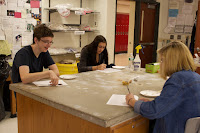Our first annual EMPTY BOWLS DINNER & FUNDRAISER will be held on
Friday, April 1, 2016, 6-9pm
in the HS Cafeteria
9/30 & 10/1 Clay Class Assignment-Library
Friday, April 1, 2016, 6-9pm
in the HS Cafeteria
9/30 & 10/1 Clay Class Assignment-Library
Empty Bowls Project
Research & Drawing Assignment
For
this EMPTY BOWL project you will create at least one bowl using the slump/hump
mold method, as well as a variety of surface decorations techniques (carving,
relief, sculpting, stamping, piercing). The bowl design will be inspired by
your favorite food or food dish. Below is a series of questions related to your
food choice. Your knowledge and understanding of how your food is
grown/created, transported, processed, sold, and prepared will help you to
develop your bowl design ideas. Your bowl will hopefully serve as reminder of
all those who struggle with food insecurity. On the back of this sheet are
directions for sketching out your bowl design ideas. ANSWER QUESTIONS IN COMPLETE SENTENCES FOR FULL CREDIT.
1.
What is your favorite food or food dish
and why did you choose this for your bowl design?
2.
List the basic ingredients for your
favorite food/food dish. If your choice is a single food item then describe how
you best like to eat it (grilled? In a salad? With hummus or dip? Etc.)
3.
All the food we eat, unless we grow it
ourselves, goes through a complex process from seed to food on our plate.
Answering the following questions will take some time to research. Be sure to
write or type the website url or the title/author of the book or magazine from
which you are sourcing your information.
a.
Where
is your food item or the 2 basic ingredients of your food dish typically grown?
What types of farms? What part of the country or world?
b.
How is your food item or 2 basic
ingredients of your food dish typically transported from farm to processing
center (factory) or store? Ship? Plane? Bus? Truck? Train? Other means?
c.
If your food item or the 2 basic
ingredients of your food dish are processed in a factory before being sold,
then what type of processing does it/do they go through? Canning? Freezing?
Curing? Drying? Freeze-drying? Other?
d.
Does your food item or the 2 basic
ingredients of your food dish require food additives to be added during the
processing stage? If
so, what type of additives are typically used. Food additives
such as those that: enhance flavor? Improving nutrition? Increase shelflife?
Maintain texture? Help foods age properly? Other?
e.
If your food item or the 2 basic
ingredients of your food dish are packaged before being sold, what type of
packaging do it/do they typically require? Boxing? Styrofoam? Plastic wrap?
Other?
f.
Where is your food item or the 2 basic
ingredients of your food dish typically sold? What type of store? Where do you
typically find it/them?
g.
What are some of the complications or
controversies surrounding your food item or the 3 basic ingredients of your
food dish? Are there issues with the use of pesticides or unsafe food
additives? Organic versus non-organic farming? Treatment of farm animals?
Factory farming versus small/local farms? Farming who grow the crops not being
paid enough? Shortage of farmland to grow your food? Natural disasters that
affect farmers’ ability to grow the food? Water shortage affecting crops? Large
farms versus small farms? Waste and greenhouse emissions? Chemicals used to
make food? Poor nutritional value? Other?

























































































